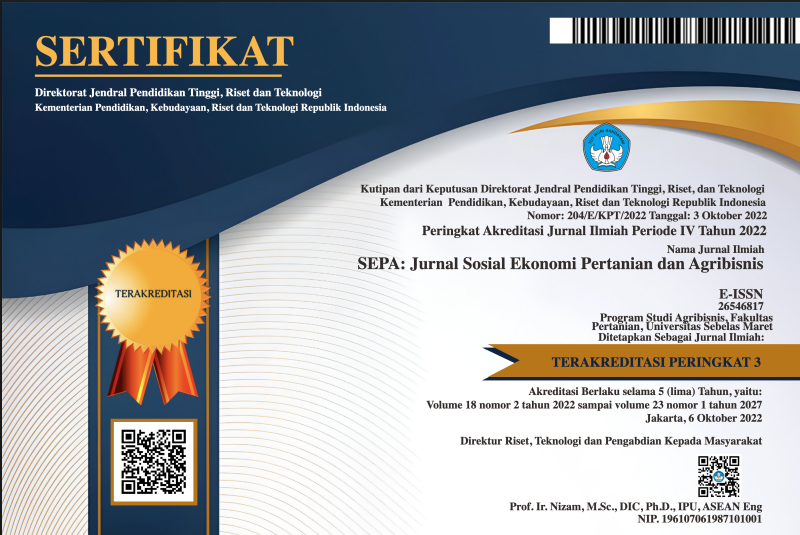POLA KONSUMSI DAN KOMPONEN YANG DIPERTIMBANGKAN OLEH KONSUMEN TEH HITAM DAN TEH HIJAU DI KECAMATAN PURWOKERTO SELATAN
Abstract
People consume black tea and green tea with certain characteristics in accordance with their wishes and needs. The rating of the product shows the attitude of the people towards a product as well and also reflects their preferences in spending and consuming a product. The aim of this research is to analyse the characteristics of black tea and green tea consumers, to analyse green tea and black tea consumption patterns, and to analyse the components that consideration the preferences of black tea and green tea consumers. Research was held in Southern Purwokerto Sub-district, started from February until March 2020. The number of samples for each black tea and green tea consumers are 50 respondents taken by using multistage random sampling. The analysis which is used is Descriptive Analysis and Factor Analysis. The results show that characteristics of black tea and green tea consumers are women in various range of age. Additionally, married consumers buy black tea and green tea to be consumed together with their family. Perspective of consumption patterns black tea and green tea once a day in the morning breakfast for black tea and in other activities for green tea. The consumption number for family is an average of 50g/months. There are three main components that form preferences on green tea, those are: personality from the tea, identity, and the image of the product. On the other hand, main components that form preferences on black tea are two, those are: image, and identity product.
Keywords
Full Text:
PDFReferences
Anggaini, T., Febrianti, F., Aisman, & Ismanto, S. D. (2016). Black Tea with Averrhoa Bilimbi L Extract: A Healthy Beverage. Agriculture and Agricultural Science Procedia, 241-252.
Badan Pusat Statistik. (2019). Statistik Teh Indonesia 2018. Jakarta: Badan Pusat Statistik.
Chacko, S. M., Thambi, P. T., Ramadasan, K., & Nishigaki, I. (2010). Beneficial Effect of Green Tea. Chinese Medicine, 5(13), 1-9.
Chung, S., Yang, & Janelle, M. L. (2000). Effects of Tea Consumption on Nutrition and Health. American Society for Nutritional Sciences. Journal Nutrition, 130, 2409-2412.
Citra, Y., Susi, & Hakim, H. M. (2018). Consumer Preference Level on Cinnamomum burmanii Tea with Analytic Hierarchy Process Method. Tropical Wetland Journal, 4(1), 008-016. doi:https://doi.org/10.20527/twj.v4i1.57
Deb, S., & K, J. P. (2016). A Review of Withering in the Processing of Black Tea. Journal of Biosystems Engineering, 265-372.
Dewan Teh Indonesia. (2019, 12 15). Perkembangan Agribisnis Teh Dunia. Retrieved from Indonesia Tea Board: http://indonesiateaboard.org/arealteh/
Eriyanto. (2007). Teknik Sampling Analisis Opini Publik. Yogyakarta: LkiS Yogyakarta.
Ghozali, I. (2018). Aplikasi Analisis Multivariate Dengan Program IBM SPSS. Semarang: Universitas Diponegoro.
Ikmanila, R., Mukson, & Setiyawan, H. (2018). Analisis Preferensi Konsumen Rumah Tangga terhadap Teh Celup di Kota Semarang. Jurnal Ekonomi dan Pembangunan Optimum, 8(1), 1-14. doi:http://dx.doi.org/10.12928/optimum.v8i1.9080
Kotler, P. (2008). Prinsi-Prinsip Pemasaran. Jakarta: Erlangga.
Mahmoudi, H., Farajpour, M., & Afradiabi, S. (2021). The preferences of consumers for organic tea: Evidence from a stated choice experiment. Journal of the Saudi Society of Agricultural Sciences, 20, 265-269. doi:https://doi.org/10.1016/j.jssas.2021.02.006
Nugraha, A., Sumarwan, U., & Simanjuntak, M. (2018). Faktor Determinan Preferensi dan Perilaku Konsumsi Teh Hitam dan Hijau. Jurnal Manajemen & Agribisnis, 14(3), 198-208. doi:https:/doi.org/10.17388/jma.14.3.198
Ramadhani, F., Barokah, U., & Sutrisno, J. (2020). Analisis Preferensi Konsumen terhadap Pembelian Teh di Kabupaten Sukoharjo. Jurnal Ilmu-Ilmu Pertanian, 4(1), 21-29. doi:https://doi.org/10.32585/ags.v4i1.838
Rohdiana, D. (2015). Teh: Proses, Karakteristik & Komponen Fungsionalnya. Food Review Indonesia, 10.
Schifman, L., & L, K. (2004). Consumer Behavior. New Jersey: Pearson Education.
Waltner , L. M., Wang, X. L., & Law, B. K. (2002). Epigalocatechin gallate, a constituent of green tea, represses hepatic glucose production. Journal Biology Chemistry, 277(38), 33-40.
Wang, C., & Li, Y. (2006). Research progress on property and application of theaflavins. African Journal of Biotechnology, 5(3), 2013-2018.
Yang, C. S., Wang, X., Lu, G., & Sonia, C. (2009). Cancer Prevention by Tea : Animal Studies, Molekular Mechanism and Human Relevance. Nat Review Cancer, 9(6), 429-439.DOI: https://doi.org/10.20961/sepa.v20i2.58512
Refbacks
- There are currently no refbacks.



.png)







.png)
3.png)





